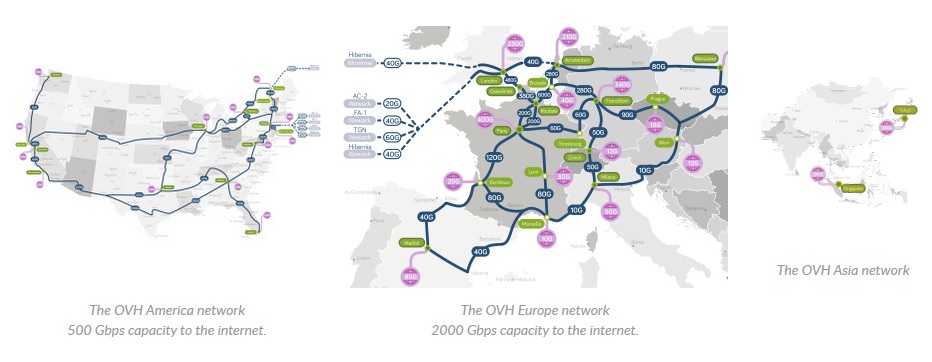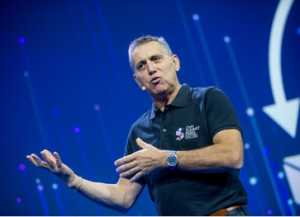A unicorn is rare, but is it unique? Discourse on this ‘philosophical’ conundrum parallels much of the positioning that Roubaix-based cloud provider OVH is now working to solidify. At the company’s annual customer event in Paris this October, OVH outlined its ‘Alternative cloud’ vision to 3,000 attendees – its distinctive ‘DNA’, but also a strategy for continued market expansion that targets mainstream adoption across all customer segments on a global scale. As founder and chairperson Octave Klaba, put it, OVH “wants to help customers, but in a different way,” while at the same time, to become “the ultimate cloud provider.”

The OVH Summit Paris opener provided a taste of the company’s distinctive character – Klaba’s own Metallica guitar performance – and a keynote address, in which the company founder pointed to difference as the secret sauce in OVH success. The success is clear: OVH is indeed a ‘unicorn’ defined as a privately held firm valued at over $1 billion+; it has over a million customers and 360,000 servers deployed; revenue is growing at a rate of 30 percent this year; it is investing 1.5 billion euros in company assets over the next five years, and plans to expand its current data centre footprint from 27 in 12 sites to 50. In its 18-year history, OVH has transitioned from a website hoster to the European cloud leader to a multinational provider with the addition of several data centres in Asia, six-year-old presence in Canada, and a newer network in the US based on last year’s acquisition of VMware’s public cloud business, vCloud Air. OVH now sells into 138 countries.
European vision
This ‘difference’, which company spokespersons describe as the foundation for OVH progress, is a more complex proposition. According Klaba, the company exhibits the “values of the European enterprises,” a theme that he returned to at the end of the event, in calls for the creation of pan-European partnership that could have global market impact in future. For cloud customers in the here and now, this value proposition translates to adherence to GDPR, the EU’s new privacy legislation, and, as Klaba, described it, “choice of a cloud with or without the Patriot Act.”
This “choice” is based on the establishment of OVH facilities in and outside the US, but may not be so clear as it appears on first blush. For customers with distributed operations, global delivery is an attractive attribute in potential cloud suppliers; however, US customers with data in European facilities would continue to be subject to the Patriot Act, as would European customers with data resident in new US data centres. The OVH response to this puzzle is to keep European and US operations functionally separate on commercial and operational levels (Russell Reeder acts as CEO of OVH US, while Michel Paulin was brought on board this August to serve as CEO for ROW), but also to migrate US customers with data in former vCloud Air data centres to facilities operated by OVH. On the question of compliance with the Patriot Act, Xavier Perret, OVH chief digital & marketing Officer (ROW) explained that if the American government asked for information residing in an OVH US facility, it would be the US corporation that chose whether or not to comply with the request for data, not OVH. If a good one, this position that is not dissimilar to the stance adopted, for example, by Microsoft, which has mounted several law suits that have worked to stimulate passage of the US Cloud Act aimed at the creation of international legislation on cloud provider obligations with respect to privacy rights around customer data.
Ultimately, Klaba’s “alternative to American and Chinese companies” is about more than privacy rights; it is part of the company’s “multi-local” delivery strategy, which CEO Michel Paulin described as OVH determination to “be very close to customers” to address questions of data sovereignty, but also to deliver on technical requirements, specifically, latency challenges that may be exacerbated in global infrastructure environments. To deliver ‘local’, OVH has built on four continents and also created a set of delivery partnerships that target some specific customers, Paulin explained, in order to serve enterprise needs at hyperscale speed. One of the company’s true differentiators, which underpins much of this delivery capability, is networking: OVH operates its own global fibre optic network which offers total capacity of 15 Tbps worldwide. With this infrastructure, OVH is able to bundle bandwidth into its cloud offerings so that customers do not see additional fees for data ingress and egress, and even to double the default bandwidth that comes with each product at no extra charge (to one Gig/second). CTO and head of product at OVH Alain Fiocco announced this “free gift in Europe and Canada (to one Gig/second, [with global rollout to follow] because they want their customers to grow.”

Freedom to choose

Klaba, who immigrated with his family to France from Poland under Soviet influence, described his personal history as “all about the search for freedom,” and he shared his determination to pass this freedom on to his customers. In the OVH schema, control over data is an important aspect of customer choice: private cloud clients choose which country they would like dedicated servers to reside in; and public cloud customers can soon choose an availability zone, without data needing to transit though a Paris centre. Similarly, OVH has four categories of infrastructure offerings, each with different remote service ‘flavours’: bare metal servers, dedicated servers, public cloud based on OpenStack accessed via the Internet, and private cloud based on VMware’s SDDC accessed through a secure gateway proxy. Ironically, the company moved a step closer to institutionalizing this choice though the articulation of four OVH “universes” that map to the “experiences” of different customer segments and the products that are most likely to meet their needs. Xavier Perret described the four universes as follow:
- OVHmarket – essentially products that the small to medium size business can use to increase productivity. This set of offerings includes the company’s foundational business, webhosting (OVH hosts 3.5 million websites, and is one of the top 10 companies in this area), as well as new SaaS based offerings announced at Summit, such as Visibilité Pro, a service that helps SMBs develop their online presence and digital reputation. OVH also announced a new business fiber service that 4 million lines in France will be eligible for, and Cloud Web – Plug&Play website hosting and email management with public cloud performance.
- OVHspirit – legacy products and traditional infrastructure, including a wide range of dedicated servers with different CPU, and GPU (Nvidia – for AI application) capabilities, storage, networking and security components that customers can assemble to build their own private cloud platform. Different monthly fees are charged, depending on server, storage, bandwidth or other service requirements – Paulin pointed to “predictable pricing” for this foundational service, as opposed to consumption-based pricing that competitors use, as a key benefit that OVH brings to users of cloud services. At Summit, OVH announced new HG-2019 servers built on Intel Skylark processers designed to address modern, data intensive use cases, such as AI and machine learning.
- OVHstack – public cloud services based on OpenStack, for which OVH is building a catalogue of services, such as the new Managed Kubernetes for the orchestration of containerized applications. OVH is not typically in the managed services business but has made this exception to support customer need for dynamic, application driven elasticity in microservices architectures. OVH also introduced the Analytics Data Platform, which automates the provision of cloud databases, such as Mongo, and delivers Big Data repositories, ex. all the pre-configured services needed for a complete Hadoop stack to support AI, BI, IoT and other advanced applications, on an hourly basis.
- OVHenterprise – a universe of offerings for large customers engaged in digital transformation who want the agility of public cloud, but the security, resilience, certification, performance and seamless migration (between platforms) that the enterprise requires. For this segment, OVH introduced a range of new software-defined data centre solutions, support and services, such as vSAN for high performance servers. The company has also introduced services aimed at key issues in cloud deployment, such as HCX, a lift and shift “hot” migration tool acquired with vCloud Air aimed at hybrid cloud migration, and vCloud Connect, which capitalizes on the company’s 33 PoPs to link on-premise infrastructure with OVH dedicated servers, virtual private cloud instances, public services and third-party clouds, in order to manage the interconnect needs of the multi-cloud environment. As Perret explained, OVH dedication to the open, multi-cloud environment, and to the use of API standards to ease data portability between clouds was demonstrated last year, when OVH joined forces with the Open Cloud Foundation.
According to Klaba, the goal of these new categories of customer universe is to simplify understanding of the OVH portfolio, rather than set rigid boundaries in consumption of OVH offerings: “the idea is not to lock yourself in,” he observed. Instead, Klaba urged customers to move through and across these different categories, which “allow you to grow your experiences, depending where you are on the digital journey.”
Support for open environments

A key piece in OVH’s vision of customer mobility, flexibility and data portability is “open” – an umbrella term that company spokespersons referenced repeatedly at Summit as a critical attribute that sets OVH apart from other vendors. While Paulin described “open” as the source of the company’s unique DNA, he explained that OVH is “compliant with all open protocols,” and pointed to its Cloud Foundation work designed to ensure that the cloud remains open, reversable, transparent and responsible. OVH is an “alternative provider,” he added, because its strategy is based on principles of open software. However, does adherence to ‘open’ make the unicorn unique? IBM has just reinforced it’s support for open standards through the acquisition of Red Hat, Google and Rackspace are believers, along with a number of other cloud providers that have built open APIs to expand customer reach. As Alain Fiocco noted, “OpenStack has been around for a long time and you can’t differentiate yourself with OpenStack.”
But at the same time, “it’s what we do with OpenStack that is different from a lot of providers,” he argued. “Most of the time what is used is Red Hat, or other distros. That’s not what we do – we operate a public cloud on OpenStack, and we are the largest operator [of this kind] in Europe and North America. Though there is a lot of private infrastructure that is OpenStack, there aren’t that many cloud providers that use OpenStack.” So with OVH, it’s a question of scale; the OVHstack foundation is OpenStack, it is deployed on dedicated servers to build a pay-as-you go solution, and in 2019, the company plans to have OpenStack bare metal servers on offer as well. As Mark Collier, OpenStack CEO and guest speaker at Summit noted, “the scale at which you [OVH] are running OpenStack is amazing.” The half a million instances a month OVH runs, “operating at an incredible scale of 150,000 petabytes of storage” enables the company to bring its industrial experience with OpenStack back benefit the whole community. At a broad infrastructure level, OVH has 24 OpenStack regions, contributing, at a marketing level, to Klaba’s vision for eliminating vendor lock in, which he believes would be impossible without open source.
According to Fiocco, OpenStack is not only a technology that provides a virtualized compute and storage environment; it is an abstraction layer that OVH uses for its public cloud. “When customers are developing a data lake on Hadoop, they don’t have to deal with servers and storage; they rely on our OpenStack abstraction layer to tap into those resources in a very simple, and nimble way,” he explained. The result is that the user is able to move much faster in developing value added services: “it’s a velocity thing; you don’t just create a project with OpenStack, it enhances productivity.”
The other advantage of OpenStack in Fiocco’s view comes from participation in an ecosystem. “If I want to be in an ecosystem like Terraform [infrastructure as code open software provided by HashiCorp.], I don’t have the time or the resources to define the entire OVH API into Terraform, into Ansible [IT automation engine], into Kubernetes. But OpenStack is there already, so by making myself available through an OpenStack API, I am becoming part of the system without doing any additional work. So people can consume those ecosystems without doing additional work” – enhancing speed to innovation.
“Innovation for Freedom”
At the Summit, Klaba translated the OVH tagline, “Innovation for Freedom” as OVH ability to support customers as they innovate and to help them keep control over their own data resources. Fiocco noted that one of the reasons that OVH is so committed to open source is that that the technology allows people to be innovative on its platform: “If we can create that ecosystem where people come to us as a marketplace, and buy the services they need to rely on our infrastructure, that’s the kind of thing we are going to focus on.”

But in a cloud world marked by commoditization, in which fees are depressed, and consumption economics, which advantages the cloud consumer who continually ups the ante in terms of service expectations in “aaS” business service models, innovation becomes increasingly difficult to deliver. For OVH, which is looking to compete with the largest of the large providers, this requirement is even more challenging: in 2016, for example, AWS boasted a new release of its core cloud service every three days, and over a thousand new features and services for that year alone. In response, OVH has focused on innovation that matters. As Fiocco explained, “My development team is not as big as that of AWS. But I would be curious to know how many of these services are put on the shelf each month, and how many are actually being used and are useful. We need to be smart about which ones we pick to bring to market. The kinds of things that we are doing with data lakes and with Kubernetes are the things our customers are asking for, that they value.”
Describing the OVH Managed Kubernetes offering, Fiocco stressed the liberating features of the new service offering. “People can come in and create their own Kubernetes environment. They will have access to the Kubernetes master for free, and it will be persistent, so if you break one and lose your policies, that will all be recovered. You can add workers nodes to that, and because our Kubernetes offering is based on the OpenStack underlay, the workers nodes will be all the flavours that we have available in the public cloud, including multiple different flavours of VMs, VPSes that you can have, which range from one core and very small memory to relatively high configurations. You can have workers do your thing dynamically, and then remove workers – and we will charge for the use of those workers like we do in the public cloud. So you have a recipe to grow and shrink dynamically through APIs within your cluster. This will be offered in all the OVH public cloud regions.”
The new Kubernetes service will be based on a pay-as-you-go model, which appears to contradict OVH insistence on predictable pricing in its cloud offering. But as Fiocco explained, information that is drawn from the client’s clusters in public cloud will be presented in metrics that help manage consumption. “You can monitor consumption, performance and how much capacity you are using – compute, storage, memory – and react based on that, including defining policies. You can say, for example, I don’t want more than 20 workers of that particular kind, or that I will only allow my employees to use this type of flavour because the others are expensive, or they don’t have the right level of performance. All of that is available as policies we can define in the clusters, and you can control these things with a lot of granularity. And because we implement all the OVH control mechanisms, you can define different roles in your cluster – this person has these specific rights, and this person needs these kinds of flavours.”
If line ups for sessions on the new offering at Summit are an indication, the Kubernetes service beta has been enormously popular. Many customers have participated, and since the betas that OVH does are fully supported, the company will likely be in a position to roll out the service to full production at the beginning of next year. In its own innovation engine, OVH combines individual creativity with organized process. “We incentivize people to innovate, and we support their activities. We have a week each quarter in which people share their inventions and listen to others describe theirs. This enables the application of innovation to new areas. We also maintain formal review committees, who look at new ideas and patent applications, and we subsidize people who submit ideas, even financially – if you submit a patent, you get a bonus. One of the incentives we offer is designed to encourage people to join the open source communities and attend the meetings – developers like to be part of those communities.” OVH has also institutionalized innovation past the ‘ideas’ phase. New concepts, product/service ideas, must pass through staged gates which include more and move people as the concept moves closer to formalized development: at stage one the innovator presents the idea; at three, the idea is challenged; at seven, it is challenged by more people, from additional areas of the business, etc.
OVH has expressed enormous confidence in its ability to continue to support customer innovation. From Fiocco’s container strategy, to Paulin’s “Smart Cloud” to Perret’s belief that a new range of server configurations will help the company better penetrate the mid-market, confidence is building within OVH as it builds process and strategy to support its impressive growth trajectory. But going forward, Klaba is also looking to partner in a federation of large European companies and individuals who can co-innovate – sharing and pooling skills which may not be abundant enough in Europe. We “need to create a virtual GFAM,” he urged, based on a “free standard created by a community that is much stronger than anything created by one, capitalistic, proprietary company” using a “European recipe to create the European Internet Giant” that will become “the largest provider in the world.” “Attempting the impossible is not being crazy,” he concluded.








